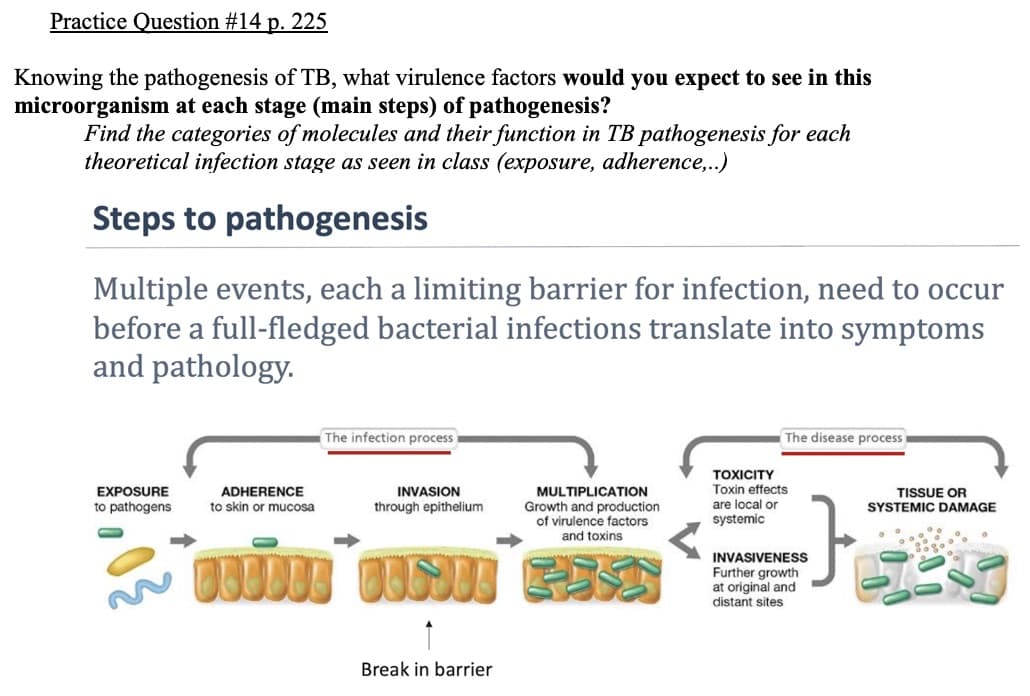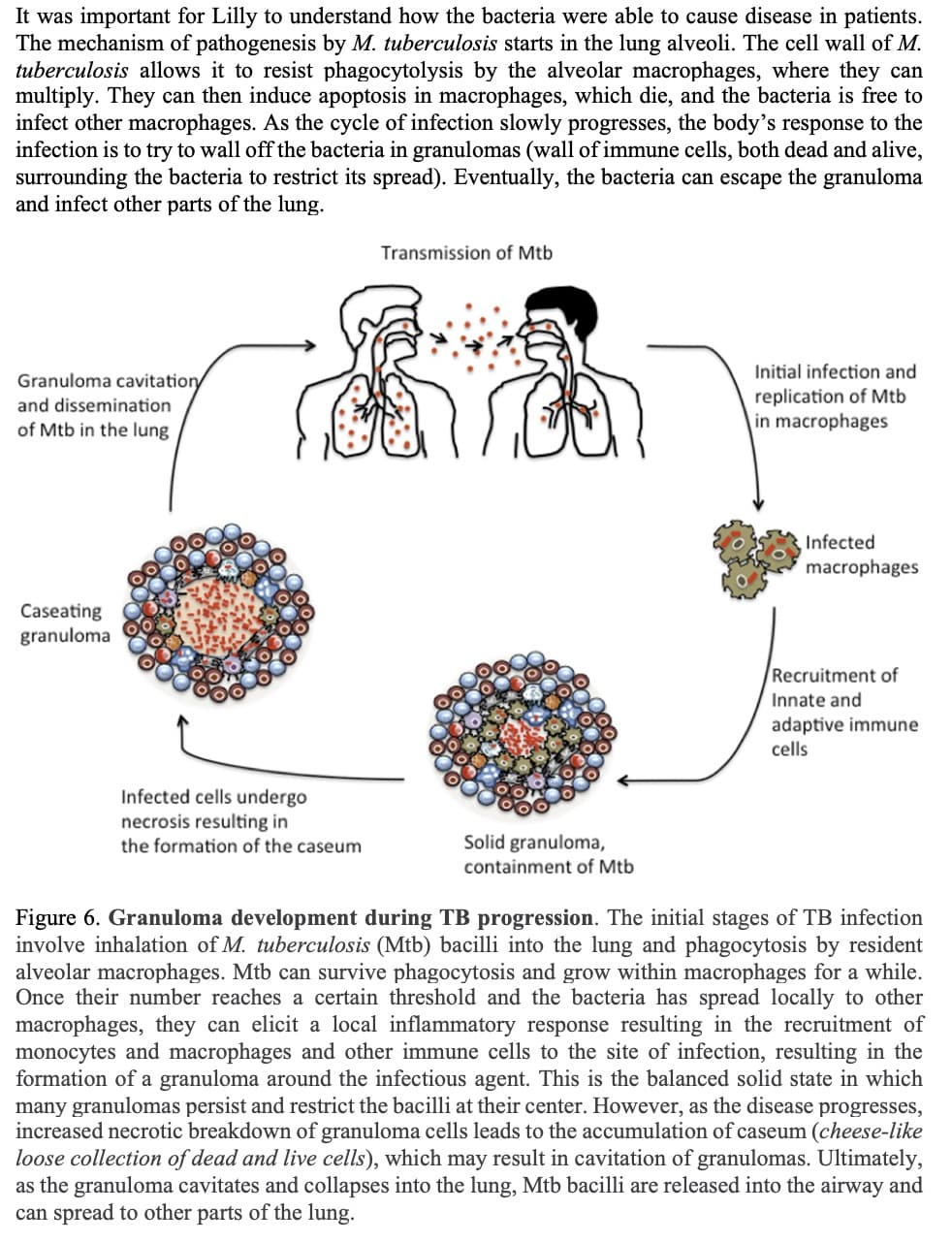Knowing the pathogenesis of TB, what virulence factors would you expect to see in this microorganism at each stage (main steps) of pathogenesis? Find the categories of molecules and their function in TB pathogenesis for each theoretical infection stage as seen in class (exposure, adherence,..) Steps to pathogenesis
Knowing the pathogenesis of TB, what virulence factors would you expect to see in this microorganism at each stage (main steps) of pathogenesis? Find the categories of molecules and their function in TB pathogenesis for each theoretical infection stage as seen in class (exposure, adherence,..) Steps to pathogenesis
Human Anatomy & Physiology (11th Edition)
11th Edition
ISBN:9780134580999
Author:Elaine N. Marieb, Katja N. Hoehn
Publisher:Elaine N. Marieb, Katja N. Hoehn
Chapter1: The Human Body: An Orientation
Section: Chapter Questions
Problem 1RQ: The correct sequence of levels forming the structural hierarchy is A. (a) organ, organ system,...
Related questions
Question

Transcribed Image Text:Practice Question #14 p. 225
Knowing the pathogenesis of TB, what virulence factors would you expect to see in this
microorganism at each stage (main steps) of pathogenesis?
Find the categories of molecules and their function in TB pathogenesis for each
theoretical infection stage as seen in class (exposure, adherence,.)
Steps to pathogenesis
Multiple events, each a limiting barrier for infection, need to occur
before a full-fledged bacterial infections translate into symptoms
and pathology.
The infection process
The disease process
ТOXICITY
Toxin effects
are local or
systemic
EXPOSURE
ADHERENCE
to skin or mucosa
INVASION
MULTIPLICATION
Growth and production
of virulence factors
and toxins
TISSUE OR
SYSTEMIC DAMAGE
to pathogens
through epithelium
INVASIVENESS
Further growth
at original and
distant sites
Break in barrier

Transcribed Image Text:It was important for Lilly to understand how the bacteria were able to cause disease in patients.
The mechanism of pathogenesis by M. tuberculosis starts in the lung alveoli. The cell wall of M.
tuberculosis allows it to resist phagocytolysis by the alveolar macrophages, where they can
multiply. They can then induce apoptosis in macrophages, which die, and the bacteria is free to
infect other macrophages. As the cycle of infection slowly progresses, the body's response to the
infection is to try to wall off the bacteria in granulomas (wall of immune cells, both dead and alive,
surrounding the bacteria to restrict its spread). Eventually, the bacteria can escape the granuloma
and infect other parts of the lung.
Transmission of Mtb
Initial infection and
Granuloma cavitationy
replication of Mtb
in macrophages
and dissemination
of Mtb in the lung
Infected
macrophages
Caseating
granuloma
Recruitment of
Innate and
adaptive immune
cells
Infected cells undergo
necrosis resulting in
the formation of the caseum
Solid granuloma,
containment of Mtb
Figure 6. Granuloma development during TB progression. The initial stages of TB infection
involve inhalation of M. tuberculosis (Mtb) bacilli into the lung and phagocytosis by resident
alveolar macrophages. Mtb can survive phagocytosis and grow within macrophages for a while.
Once their number reaches a certain threshold and the bacteria has spread locally to other
macrophages, they can elicit a local inflammatory response resulting in the recruitment of
monocytes and macrophages and other immune cells to the site of infection, resulting in the
formation of a granuloma around the infectious agent. This is the balanced solid state in which
many granulomas persist and restrict the bacilli at their center. However, as the disease progresses,
increased necrotic breakdown of granuloma cells leads to the accumulation of caseum (cheese-like
loose collection of dead and live cells), which may result in cavitation of granulomas. Ultimately,
as the granuloma cavitates and collapses into the lung, Mtb bacilli are released into the airway and
can spread to other parts of the lung.
Expert Solution
This question has been solved!
Explore an expertly crafted, step-by-step solution for a thorough understanding of key concepts.
This is a popular solution!
Trending now
This is a popular solution!
Step by step
Solved in 2 steps

Knowledge Booster
Learn more about
Need a deep-dive on the concept behind this application? Look no further. Learn more about this topic, biology and related others by exploring similar questions and additional content below.Recommended textbooks for you

Human Anatomy & Physiology (11th Edition)
Biology
ISBN:
9780134580999
Author:
Elaine N. Marieb, Katja N. Hoehn
Publisher:
PEARSON

Biology 2e
Biology
ISBN:
9781947172517
Author:
Matthew Douglas, Jung Choi, Mary Ann Clark
Publisher:
OpenStax

Anatomy & Physiology
Biology
ISBN:
9781259398629
Author:
McKinley, Michael P., O'loughlin, Valerie Dean, Bidle, Theresa Stouter
Publisher:
Mcgraw Hill Education,

Human Anatomy & Physiology (11th Edition)
Biology
ISBN:
9780134580999
Author:
Elaine N. Marieb, Katja N. Hoehn
Publisher:
PEARSON

Biology 2e
Biology
ISBN:
9781947172517
Author:
Matthew Douglas, Jung Choi, Mary Ann Clark
Publisher:
OpenStax

Anatomy & Physiology
Biology
ISBN:
9781259398629
Author:
McKinley, Michael P., O'loughlin, Valerie Dean, Bidle, Theresa Stouter
Publisher:
Mcgraw Hill Education,

Molecular Biology of the Cell (Sixth Edition)
Biology
ISBN:
9780815344322
Author:
Bruce Alberts, Alexander D. Johnson, Julian Lewis, David Morgan, Martin Raff, Keith Roberts, Peter Walter
Publisher:
W. W. Norton & Company

Laboratory Manual For Human Anatomy & Physiology
Biology
ISBN:
9781260159363
Author:
Martin, Terry R., Prentice-craver, Cynthia
Publisher:
McGraw-Hill Publishing Co.

Inquiry Into Life (16th Edition)
Biology
ISBN:
9781260231700
Author:
Sylvia S. Mader, Michael Windelspecht
Publisher:
McGraw Hill Education